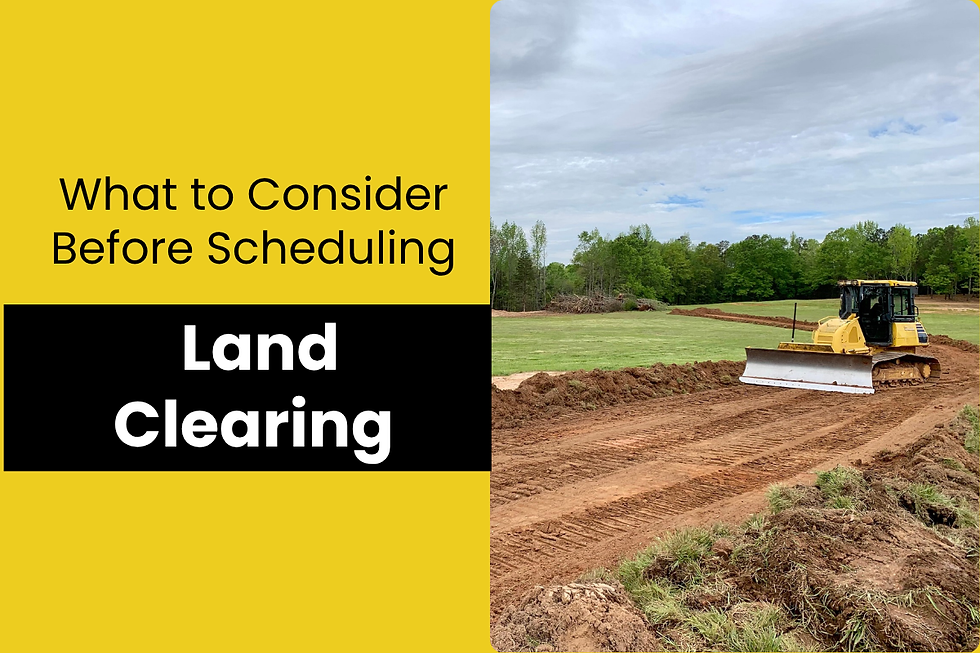What to Consider Before Scheduling Land Clearing During Rainy Seasons
- seoatchandigarh315
- Aug 6
- 3 min read

Land clearing is a crucial first step for many construction, landscaping, or agricultural projects. But if you're thinking about scheduling land clearing during the rainy season, there are a few important things to keep in mind. While it might seem like just another job on your project list, working with wet conditions can quickly turn into a costly mistake if you’re not prepared.
In this post, we’ll go over the key things you need to consider before moving forward and how experienced land clearing contractors can help you avoid common pitfalls.
Soil Conditions Matter More Than You Think
Rainy weather leads to wet, muddy soil and that’s a big red flag for land clearing operations. Heavy equipment like bulldozers and mulchers can sink into soft ground, making it difficult to move efficiently and potentially damaging the site. Wet soil can also lead to uneven clearing, compaction, or rutting, which can affect your project’s foundation or future landscaping.
Before scheduling any work, it’s important to assess the drainage of your property. If water tends to pool or the area remains soggy days after rain, it may be best to wait for drier conditions or bring in a land clearing contractor who understands how to work with challenging terrain.
Safety Risks Increase During Wet Conditions
Operating machinery on slippery surfaces is risky business. Not only does it create dangerous working conditions for operators and workers, but it also increases the likelihood of accidents, equipment damage, or environmental impact.
Clearing trees, brush, or undergrowth in the rain also poses visibility issues and makes it harder to control where debris falls. That’s why landowners should always work with professionals who follow safety protocols and understand the common land clearing challenges associated with rainy seasons.
Access to the Site May Be Limited
Heavy rain can wash out access roads or create deep mud that blocks equipment from entering or exiting the site. This could delay your entire project timeline and add unexpected costs for repairs or alternative access routes.
Smart planning means checking weather forecasts, knowing your site layout, and understanding which parts of the land are most likely to flood or hold water. Some land clearing contractors may recommend temporary roads or mats to help keep the project on schedule without damaging the site.
Environmental Concerns & Erosion Control
Rain can quickly lead to soil erosion if the land isn’t properly prepared. Removing trees and vegetation exposes the topsoil, which is vulnerable to being washed away. This can lead to long-term damage, especially on sloped areas, and may require expensive soil restoration.
Experienced contractors understand this and will often use best practices such as silt fencing, erosion control blankets, or temporary ground cover to minimize damage. This is one of the common land clearing challenges that many DIY projects overlook.
Cost Implications and Delays
Working in wet conditions often takes longer, requires more precautions, and can damage machinery all of which add to the cost. In some cases, contractors may charge more for rainy season projects because of the extra effort involved.
If you’re on a budget or tight schedule, it may be more cost-effective to wait for drier months. However, if you absolutely must proceed, working with a trusted land clearing contractor who’s experienced in wet-season conditions will save you time and stress in the long run.
Permitting and Local Regulations
Some regions have specific rules about land clearing during rainy seasons due to increased risks of runoff, flooding, or erosion. Make sure to check your local permitting requirements. Your contractor should also be familiar with any restrictions and help guide you through the process if special measures are needed.
Final Thoughts
Clearing land in the rainy season isn’t impossible but it does come with a unique set of challenges. From soil stability and site access to safety concerns and environmental risks, timing your land clearing project wisely is essential.
By being aware of these common land clearing challenges and working with reliable land clearing contractor, you can protect your land, your investment, and your project timeline. Always plan ahead, monitor weather forecasts, and don’t hesitate to seek expert advice when you’re unsure. A little extra planning can save you a lot of trouble down the road.







